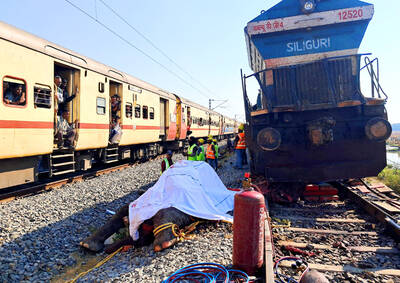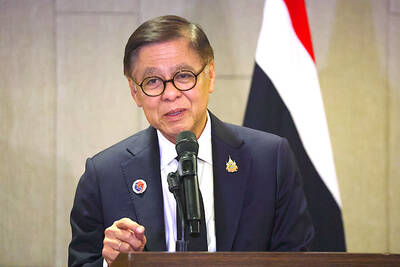At a bustling market in the capital city, Cambodia's heritage is being sold off: ancient beads are snapped up at two for US$1, while US$15 buys a 3,500-year-old stone tool.
Sales of such antiquities are booming at markets across the kingdom, robbing it of a rich history archaeologists are only beginning to study after decades of conflict ended here in 1998.
Ceramic pots and bronze bracelets may seem innocuous spoils compared with the stunning statuary prized by "tomb raiders," but their theft from underground sites means Cambodia's prehistory is being irretrievably lost, experts say.
"Most archaeologists are not really interested in finding a giant statue of Buddha or a single magnificent artefact. We're interested in spatial context," says Kyle Latinis, a US archaeologist specializing in Southeast Asia.
For items such as humble beads or tools to be useful to historians, they must be studied and assessed while still in the ground.
But with mines being cleared across war-ravaged Cambodia, farmers are clearing formerly dangerous land and uncovering artefacts they quickly pass to middlemen. And when archaeologists are called in, their finds fall prey to looters.
"We can't make head or tail out of a site that's been looted. It's killing historical interpretation," laments Latinis, who acknow-ledges that desperately poor Cambodians are often compelled to sell their finds.
The middlemen move the artefacts to local markets, where they are affordable enough for both Cambodians and tourists to buy, or they shift into the international black market, which is as yet unquantified and unstudied.
UNESCO removed the majestic Angkor Wat temple complex, the country's most treasured landmark, from its World Heritage in Danger list this month, de-scribing its preservation as "a success story."
Illicit excavation, pillaging and landmines were the main threats that put the capital of the ancient Khmer Empire on the list in the first place. Angkor Wat, founded in the ninth century, is Cambodia's main tourist destination today.
Dougald O'Reilly, director of Heritage Watch, which is working to protect Cambodia's buried cultural riches, emphasizes the global importance of this knowledge.
"In terms of world archaeolo-gy, Cambodia is an amazing gold mine, and it's completely unknown. Angkor is one of the greatest civilizations in the world, and as prehistorians we know nothing about how that came about."
Extensive burial sites containing huge iron swords and helmets decorated with buffalo horns -- items never before seen in the region -- have been wiped out by looters, O'Reilly says.
The new government's culture minister, Chuch Phoern, says the laws are excellent but police are untrained and citizens remain unaware of what antiquities should be protected.
"We plan under the new mandate of the government to educate people and inculcate deeply the laws concerning protection and preservation," he says.
Heritage Watch, formed earlier this year, also aims to educate villagers about the items' value and plans to establish museums in threatened areas.
O'Reilly says the hope is that such sites will generate long-term income.
"We'd like village people to make a living off that sustainable resource, thereby perhaps passing on the message that they don't need to loot the stuff and sell it so it's gone forever."

REVENGE: Trump said he had the support of the Syrian government for the strikes, which took place in response to an Islamic State attack on US soldiers last week The US launched large-scale airstrikes on more than 70 targets across Syria, the Pentagon said on Friday, fulfilling US President Donald Trump’s vow to strike back after the killing of two US soldiers. “This is not the beginning of a war — it is a declaration of vengeance,” US Secretary of Defense Pete Hegseth wrote on social media. “Today, we hunted and we killed our enemies. Lots of them. And we will continue.” The US Central Command said that fighter jets, attack helicopters and artillery targeted ISIS infrastructure and weapon sites. “All terrorists who are evil enough to attack Americans are hereby warned

‘POLITICAL LOYALTY’: The move breaks with decades of precedent among US administrations, which have tended to leave career ambassadors in their posts US President Donald Trump’s administration has ordered dozens of US ambassadors to step down, people familiar with the matter said, a precedent-breaking recall that would leave embassies abroad without US Senate-confirmed leadership. The envoys, career diplomats who were almost all named to their jobs under former US president Joe Biden, were told over the phone in the past few days they needed to depart in the next few weeks, the people said. They would not be fired, but finding new roles would be a challenge given that many are far along in their careers and opportunities for senior diplomats can

Seven wild Asiatic elephants were killed and a calf was injured when a high-speed passenger train collided with a herd crossing the tracks in India’s northeastern state of Assam early yesterday, local authorities said. The train driver spotted the herd of about 100 elephants and used the emergency brakes, but the train still hit some of the animals, Indian Railways spokesman Kapinjal Kishore Sharma told reporters. Five train coaches and the engine derailed following the impact, but there were no human casualties, Sharma said. Veterinarians carried out autopsies on the dead elephants, which were to be buried later in the day. The accident site

RUSHED: The US pushed for the October deal to be ready for a ceremony with Trump, but sometimes it takes time to create an agreement that can hold, a Thai official said Defense officials from Thailand and Cambodia are to meet tomorrow to discuss the possibility of resuming a ceasefire between the two countries, Thailand’s top diplomat said yesterday, as border fighting entered a third week. A ceasefire agreement in October was rushed to ensure it could be witnessed by US President Donald Trump and lacked sufficient details to ensure the deal to end the armed conflict would hold, Thai Minister of Foreign Affairs Sihasak Phuangketkeow said after an ASEAN foreign ministers’ meeting in Kuala Lumpur. The two countries agreed to hold talks using their General Border Committee, an established bilateral mechanism, with Thailand